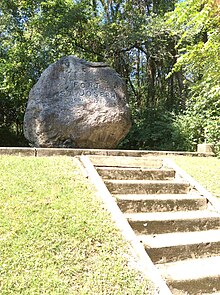| Fort Saint Joseph | |
|---|---|
| Niles, Michigan | |
 Monument at the former site of the fort | |
| Coordinates | 41°48′49″N 86°15′44″W / 41.813675°N 86.262288°W |
| Site history | |
| Built | 1691 |
| Built by | French |
| In use | Fur Trade Post |
| Demolished | 1795 |
| Battles/wars | American Revolution |
| Events | Pontiac's Rebellion, Raid of 1780 and Raid of 1781 |
Fort St. Joseph Site (20BE23) | |
| Location | Niles, Michigan |
| Coordinates | 41°48′49″N 86°15′44″W / 41.81361°N 86.26222°W |
| NRHP reference No. | 73000944[1] |
| Significant dates | |
| Added to NRHP | May 24, 1973 |
| Designated MSHS | February 18, 1956[2] |


Fort Saint Joseph was a fort established on land granted to the Jesuits by King Louis XIV; it was located on what is now the south side of the present-day town of Niles, Michigan. Père Claude-Jean Allouez established the Mission de Saint-Joseph in the 1680s. Allouez ministered to the local Native Americans, who were primarily Odawa and Ojibwe.
The French built the fort in 1691 as a trading post on the lower Saint Joseph River. It was located where one branch of the Old Sauk Trail, a major east-west Native American trail, and the north-south Grand River Trail meet; together the combined trail fords the river. The fort was a significant stronghold of the fur trade at the southern end of Lake Michigan. Prior to the French and Indian War (the North American front of the Seven Years' War in Europe), the post had a French garrison of 10 soldiers, a commandant, blacksmith, Catholic priest, interpreter, and 15 additional households.[3]
Following their victory in the war, the British took over the fort and maintained it for the fur trade. During the American Revolutionary War, they used it to supply their American Indian allies against the rebellious Continentals. The Spanish raided the fort in 1781 and briefly claimed it and the St. Joseph River as their territory. The British maintained the fort until after the United States victory in the Northwest Indian War and the signing of Jay's Treaty in 1795. This settled the northern border. After the British abandoned the fort, it fell into ruin and was overtaken by forest.
The fort site was not rediscovered until 1998. An archeology excavation has been underway since 2002. Among the rare artifacts discovered is an intact Jesuit religious medallion from the 1730s, one of only two found in North America. In December 2010, the team revealed a foundation wall and corner posts of one of the original buildings.
The site is listed on the National Register of Historic Places and is a state-registered site as well.
- ^ "National Register Information System". National Register of Historic Places. National Park Service. 2009-03-13.
- ^ State of Michigan (2009). "Fort St. Joseph Site (20BE23)". Retrieved June 26, 2010.
- ^ Nassaney, 28
© MMXXIII Rich X Search. We shall prevail. All rights reserved. Rich X Search


